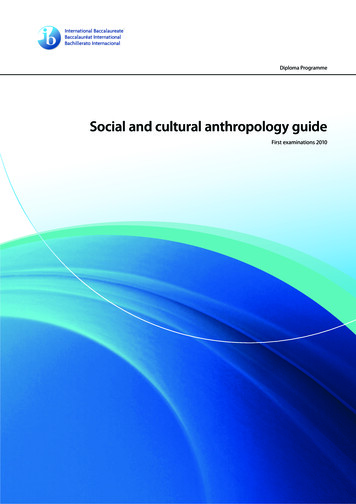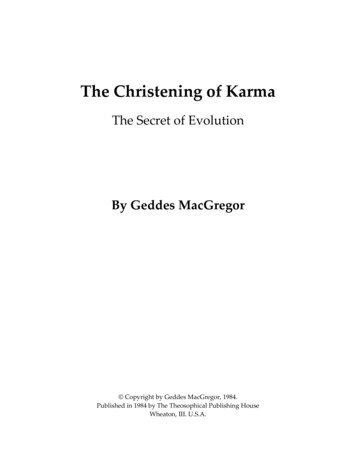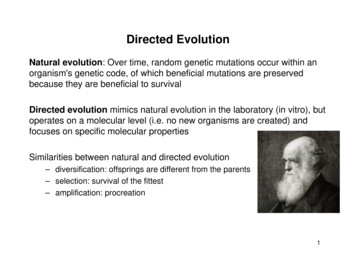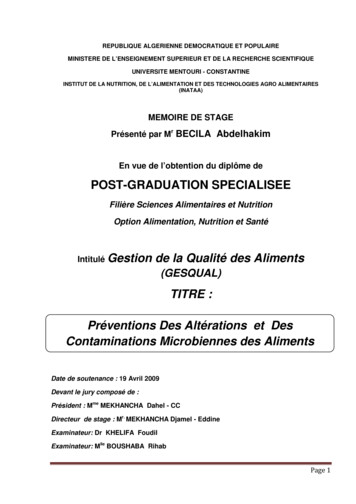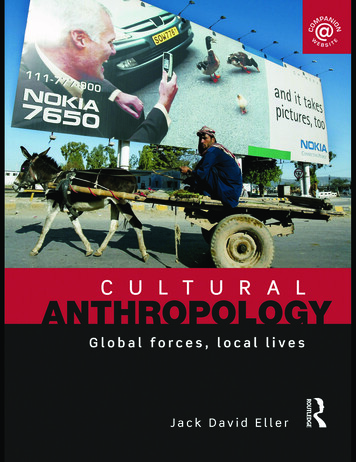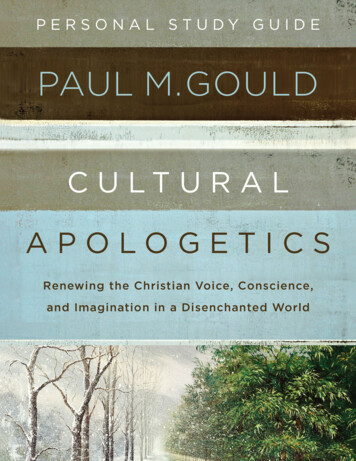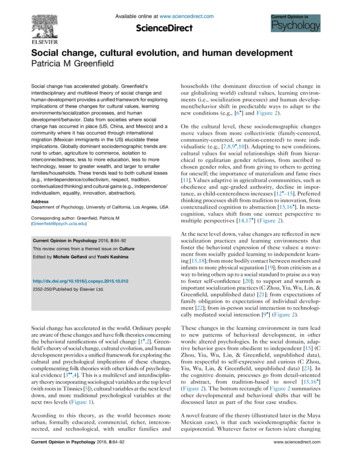
Transcription
Available online at www.sciencedirect.comScienceDirectSocial change, cultural evolution, and human developmentPatricia M GreenfieldSocial change has accelerated globally. Greenfield’sinterdisciplinary and multilevel theory of social change andhuman development provides a unified framework for exploringimplications of these changes for cultural values, learningenvironments/socialization processes, and humandevelopment/behavior. Data from societies where socialchange has occurred in place (US, China, and Mexico) and acommunity where it has occurred through internationalmigration (Mexican immigrants in the US) elucidate theseimplications. Globally dominant sociodemographic trends are:rural to urban, agriculture to commerce, isolation tointerconnectedness, less to more education, less to moretechnology, lesser to greater wealth, and larger to smallerfamilies/households. These trends lead to both cultural losses(e.g., interdependence/collectivism, respect, tradition,contextualized thinking) and cultural gains (e.g., independence/individualism, equality, innovation, abstraction).AddressDepartment of Psychology, University of California, Los Angeles, USACorresponding author: Greenfield, Patricia M(Greenfield@psych.ucla.edu)Current Opinion in Psychology 2016, 8:84–92This review comes from a themed issue on CultureEdited by Michele Gelfand and Yoshi 0122352-250/Published by Elsevier Ltd.households (the dominant direction of social change inour globalizing world) cultural values, learning environments (i.e., socialization processes) and human development/behavior shift in predictable ways to adapt to thenew conditions (e.g., [6 ] and Figure 2).On the cultural level, these sociodemographic changesmove values from more collectivistic (family-centered,community-centered, or nation-centered) to more individualistic (e.g., [7,8,9 ,10]). Adapting to new conditions,cultural values for social relationships shift from hierarchical to egalitarian gender relations, from ascribed tochosen gender roles, and from giving to others to gettingfor oneself; the importance of materialism and fame rises[11]. Values adaptive in agricultural communities, such asobedience and age-graded authority, decline in importance, as child-centeredness increases [12 –15]. Preferredthinking processes shift from tradition to innovation, fromcontextualized cognition to abstraction [15,16 ]. In metacognition, values shift from one correct perspective tomultiple perspectives [14,17 ] (Figure 2).At the next level down, value changes are reflected in newsocialization practices and learning environments thatfoster the behavioral expression of these values: a movement from socially guided learning to independent learning [15,18]; from more bodily contact between mothers andinfants to more physical separation [19]; from criticism as away to bring others up to a social standard to praise as a wayto foster self-confidence [20]; to support and warmth asimportant socialization practices (C Zhou, Yiu, Wu, Lin, &Greenfield, unpublished data) [21]; from expectations offamily obligation to expectations of individual development [22]; from in-person social interaction to technologically mediated social interaction [9 ] (Figure 2).Social change has accelerated in the world. Ordinary peopleare aware of these changes and have folk theories concerningthe behavioral ramifications of social change [1 ,2]. Greenfield’s theory of social change, cultural evolution, and humandevelopment provides a unified framework for exploring thecultural and psychological implications of these changes,complementing folk theories with other kinds of psychological evidence [3 ,4]. This is a multilevel and interdisciplinary theory incorporating sociological variables at the top level(with roots in Tönnies [5]), cultural variables at the next leveldown, and more traditional psychological variables at thenext two levels (Figure 1).These changes in the learning environment in turn leadto new patterns of behavioral development, in otherwords: altered psychologies. In the social domain, adaptive behavior goes from obedient to independent [15] (CZhou, Yiu, Wu, Lin, & Greenfield, unpublished data),from respectful to self-expressive and curious (C Zhou,Yiu, Wu, Lin, & Greenfield, unpublished data) [23]. Inthe cognitive domain, processes go from detail-orientedto abstract, from tradition-based to novel [15,16 ](Figure 2). The bottom rectangle of Figure 2 summarizesother developmental and behavioral shifts that will bediscussed later as part of the four case studies.According to this theory, as the world becomes moreurban, formally educated, commercial, richer, interconnected, and technological, with smaller families andA novel feature of the theory (illustrated later in the MayaMexican case), is that each sociodemographic factor isequipotential. Whatever factor or factors is/are changingCurrent Opinion in Psychology 2016, 8:84–92www.sciencedirect.com
Social change, cultural evolution and human development Greenfield 85Figure 1Figure 2SOCIODEMOGRAPHIC CHANGESOCIODEMOGRAPHICS(DOMINANT DIRECTION)CULTURAL RCONNECTED WITHISOLATED FROMOUTSIDE WORLDLESSTECHNOLOGYFORMAL EDUCATIONWEALTHMORE3 GENERATIONHOUSEHOLDSNUCLEAR FAMILYMANYCHILDRENONELIVING WITH OTHERSLIVING ALONEVALUE ISMGENDER IENCEmost rapidly will drive cultural and psychological changein a particular time or place.LESSAGE-GRADED AUTHORITYCHILD-CENTEREDNESSTRADITIONCONTEXTUALIZED THINKINGINNOVATIONABSTRACTIONCurrent Opinion in PsychologyA multilevel model linking sociological, cultural, environmental, andbehavioral variables. Solid arrows denote the main causal pathway,with dashed arrows indicating an alternative causal pathway.INDIVIDUALISMHIERARCHYASCRIPTIONLEARNING ENVIRONMENT/SOCIALIZATION CHANGEMOREMOTHER-INFANT BODILY CONTACTLESSSOCIAL MILY OBLIGATIONEXPECTATIONSINDIVIDUAL PMENTAL/BEHAVIORAL CHANGEIn order to show the interrelation of multiple levels(depicted by the vertical arrows in Figure 1), four casestudies will be presented. Their variety illustrates animportant fact: social change is pervasive in the world;it is not limited to so-called developing countries. Nor is itlimited to social change that occurs in one’s place of birth:around the world, people move from poorer to wealthiersocieties, from rural to urban environments, from placeswith little opportunity for formal education to places withmore, from low tech environments to high-tech environments. Hence the theory can apply to migration situations. Three of the four case studies relate to socialchange in place: The United States, China, and the Mayaof Chiapas. One relates to migration: Latino immigrationfrom Mexico and Central America to the United SOCIALSKILLSTECHNOLOGICALMORESOCIAL BONGINGLESSASCRIBEDGENDER Y FOR OTHERSLESSSELFINTERNAL FEELING STATESSELF-ESTEEMMOREFITTING INSTANDING OUTUNIQUENESSCOOPERATIONCOMPETITIONCurrent Opinion in PsychologyBut societies and migrant populations also have theirdiscrepancies, dialectics, and disconnects in the processof adapting to social change — for example, a discrepancybetween behavior and values, with shifting values sometimes leading corresponding shifts in the learning environment, and altered learning environments sometimesleading corresponding shifts in values [24 ,25]. For inwww.sciencedirect.comModel of social change, cultural evolution, and human development.Relationships for which there is empirical evidence, described in thetext, have been selected for inclusion. While the horizontal arrowsrepresent the dominant direction of social change in the world,sociodemographic change can go in the opposite direction [52 ]. Inthat case all the horizontal arrows would be reversed.Current Opinion in Psychology 2016, 8:84–92
86 Culturestance, Thein-Lemelson discusses a case in rapidlychanging Burma/Myanmar, a country emerging fromglobal isolation and moving into a market economy. Inthis particular family, the father verbally espouses independence as a developmental goal for his daughters; yethis six-year-old daughter was considered too young tobrush her own teeth [24 ]. Here the father’s values haveshifted before they are supported by changes in the homelearning environment. On the other hand, Thein-Lemelson describes the opposite situation: a Burmese motherverbally supports developmental goals adaptive in Burma’s highly controlled and predominantly agriculturaleconomy, such as understanding age-based hierarchyand respect for authority; yet her son’s urban privateelementary school, a product of the emerging marketeconomy, emphasizes the developmental goal of independence, with socialization practices that lead to theboy’s independent behaviors at home — such as washinghis own face. Here a learning environment at schooladapted to the newly privatized economy, and resultingindependent child behavior at home, is paired withunchanged parental values.of more than one culture [28]. Disconnects are frequent inthe process of migration [29,30]; for example, returnmigrants from individualistic countries such as Australiafind that they must readjust to contrasting cultural practices in their native Hong Kong — for example, educationby effortful memorization in Hong Kong compared withthe independent exploration found in the learning environments of Australian education [30].Although not acknowledged by classical modernizationtheory (e.g., [31]) sociodemographic trends are bidirectional — for example, not just from poor to wealthy, butalso from wealthy to poor; the theory predicts thatchanges in culture, learning environments, and psychology are correspondingly bidirectional; a study of socialchange in the United States (noted in the next section)tests this prediction. Also unlike classical modernizationtheory, the theory of social change and human development considers cultural losses as well as cultural gains —for example, as individual independence grows over time,family closeness diminishes (e.g., [15]).The United StatesDialectical processes also occur in social change: Chennotes the directionality of global social change toward thecoexistence and integrations of diverse value systems(e.g., individualistic and collectivistic) [26]; Hong andcolleagues focus on multicultural identities [27]; and Chiuand Kwan discuss simultaneous encounter with symbolsSociodemographic change and cultural changeAs an index of long-term sociodemographic change in theUnited States, the proportion of urban population in theUnited States rose steadily between 1800 and 2000 [12 ](Figure 3). Between the late 1800s and the 2000s, familysize and multigenerational households declined in fre-Figure 0YearCurrent Opinion in PsychologyPercentage of U.S. population living in rural and urban areas from 1800 to 2000. The data sources for the graph in Figure 3 were as follows:1800–1980 (U.S. Census Bureau, 2004); 1990 (U.S. Bureau of the Census, 1992); 2000: (U.S. Census Bureau, 2004). The operational definition ofurban population used through 1960 was people ‘living in incorporated places of 2500 inhabitants or more and in areas (usually minor civildivisions) classified as urban under special rules relating to population size and density’ (U.S. Census Bureau, 1953, p. 9). The definitionintroduced in 1950 was: ‘all persons living in (a) places of 2500 inhabitants or more incorporated as cities, boroughs, and villages, (b) incorporatedtowns of 2500 inhabitants or more incorporated as cities, boroughs, and villages, (c) the densely settled urban fringe, including both incorporatedand unincorporated areas, around cities of 50,000 or more, and (d) unincorporated places of 2500 inhabitants or more outside any urban fringe’(U.S. Census Bureau, 1953, p. 9). As seen in the graph, the Census Bureau used both definitions in 1950 and 1960, allowing one to see how theyrelate to each other. In 2000, the definition changed to densely settled territory, termed urbanized areas and urban clusters. In all definitions ofurban, the remaining population is considered rural.Figure and caption reproduced from Greenfield [12 ].Current Opinion in Psychology 2016, 8:84–92www.sciencedirect.com
Social change, cultural evolution and human development Greenfield 87quency, as single-child families and living alone becamemore frequent family and household structures [32 ].On the cultural level, content analysis of millions ofbooks, using the Google Ngram Viewer, showed that,simultaneous with these sociodemographic shifts, individualistic words (e.g., choose, personal, individual, self,unique, special), first-person singular pronouns (e.g., I,me, mine), unique children’s names, and the word childitself (indexing a rise in child-centeredness) also rose. Inthis same period of time, collectivistic words (e.g., duty,give, harmony, belong, compassion), first-person plural pronouns (we, us, ours), words signifying hierarchical socialrelations (obedience, authority), and words related to thepractice of religion in everyday life ( pray, worship) alsobecame less frequent [12 ,32 –36 ]. Figure 4 showsexamples of these trends. Another individualistic culturaltrend, the promotion of equal rights in the realm ofgender, was manifest in a rising proportion of femalepronouns relative to male pronouns in books betweenthe 1960s and the 2000s [37 ].Change in cultural values, learning environments andhuman development/psychologyIn line with the rise in individualistic content and thedecline of collectivistic content in books, the content ofthe two most popular preteen television shows for eachdecade from the 1960s to the 2000s changed drastically inthe values they manifest: community feeling declined as avalue as fame and wealth rose [11]. A survey of 9–15-yearolds showed that individualistic, self-focused aspirations,such as fame, were tied to watching TV, as well as toactively using a social networking site, a recipe for thenarcissism that is part and parcel of the fame motivation.In contrast, collectivistic, other-focused aspirations wereassociated with older nontechnology activities, most ofwhich were intrinsically social [38 ].Figure t Opinion in PsychologyTop panel: Increases in frequency of words indexing adaptation to more urban, educated, wealthy, and technological environments in the UnitedStates from 1800 through 2000. Bottom panel: Decreases in frequency of words indexing adaptations to more rural, less educated, poorer, andless technological environments from 1800 through 2000.Figure from Greenfield [12 ].www.sciencedirect.comCurrent Opinion in Psychology 2016, 8:84–92
88 CultureThese and other studies support a key theoretical idea:that communication technologies develop individualisticbehaviors, attitudes, and values [39]. In-person socialinteraction not only develops social motivations; it alsodevelops social skills, such as skill in reading the emotions of others [40 ]. Compared with communicating bymeans of technology, communicating with another person face to face maximizes the sense of bonding betweenfriends [41 ].Many other kinds of psychological shifts occurred as theUnited States became wealthier, more urban, more welleducated, and more technological. Children, early adolescents, high-school students, and college studentsincreased in self-esteem and positive self-views between the 1960s and the 2000s [42–45]; increasingly,they favored self-enhancement values such as money,fame, and image [46]. At the same time, communal traitssuch as empathy have declined [47], while the importance of internal feeling states increased [48]. Reflecting individualism in the domain of gender, there hasbeen historical movement in the United States fromascribed roles of wife and mother to chosen roles in thedomains of education and career, as well as increasingfreedom from the constraints of marriage and sexualfidelity [49 –51].Reversing these trendsHowever, the theory also predicts that reversing sociodemographic trends, for example, wealth reduction, willreverse cultural and psychological trends. In line withthis prediction, yearly national surveys of college students from 1976 to 2010 showed that concern for othersand for the environment were higher during times ofrelative economic deprivation, while materialism andpositive self-views were higher in better economictimes. With respect to positive self-views, the GreatRecession was an historical exception, probably becauseof conflicting sociodemographic trends: the increasingrole of technology seemed to overwhelm reduced economic level; and self-views continued to become morepositive, even as concern for others and for the environment rose [52 ].Chinause (first-person plural) and some collectivistic nouns andverbs declined in the same period (e.g., help, sacrifice) andthe frequency of these words was negatively correlatedwith national increases in wealth, level of formal education, and urban population. At the same time, the incredibly rapid social change that China has undergone wasreflected in a collectivistic reaction, so that some collectivistic words (obliged, give, family) increased in frequency,a situation indicating the simultaneous presence of twovalue systems [53 ,26].Socialization change and developmental changeThese sociodemographic and cultural changes are alsoreflected in child socialization and development. On thelevel of socialization, grandmothers (who raised theirown children and are now actively involved with theirgrandchildren) remember being parented more critically and with less praise and support than their grandchildren are being parented (C Zhou, Yiu, Wu, Lin, &Greenfield, unpublished data). They also recall themselves as significantly more obedient than their ownchildren during childhood, and their own children assignificantly more obedient than their grandchildren.Also as expected, they see their grandchildren as moreautonomous, extraverted, curious, and self-expressivethan their own children were during childhood, and theirown children as having been more autonomous, extraverted, curious, and self-expressive than they themselves were as children.In line with grandmothers’ perceptions of socialchange, child surveys, teacher observations, and schoolrecords reveal that shyness used to be a positive trait inChinese children (associated with social and academicachievement). But because extraversion is now moreadaptive than shyness in the environment of a marketeconomy, shyness has come to be associated with maladjustment (peer rejection, school problems, and depression) [56 ]. Not only actual social change, butparental perceptions of social change can have an impact on socialization. The reports of Chinese adolescents that their parents were warm and encouraging ofindependence were correlated with their parents’ perceptions of social change in terms of new opportunitiesand prospects [21].Sociodemographic change and cultural changeOn the cultural level, as China rapidly developed amarket economy, individualistic pronoun use (first-person singular) and individualistic verbs, adjectives, andnouns (e.g., choose, private, freedom, and rights), as well aslexical indicators of materialism (e.g., get), became morefrequent in the thousands of Chinese books analyzed bythe Google Ngram Viewer [53 ,54 ,55]. As predicted byGreenfield’s theory, increases in this period were significantly correlated with national increases in wealth, levelof formal education, and urban population [53 ]. Also aspredicted on theoretical grounds, collectivistic pronounCurrent Opinion in Psychology 2016, 8:84–92MexicoSociodemographic change and cultural changeIn Zinacantec Maya communities in highland Chiapas,woven and embroidered patterns went from uniformtradition to individual innovation, as the economic foundation of the community moved from subsistence andagriculture to money and commerce [15]. The TzotzilMaya word for ‘different’ went from a negative to apositive, showing that fitting in became a less importantvalue, while individual uniqueness became more valued.As the economy became more commercial, the learningwww.sciencedirect.com
Social change, cultural evolution and human development Greenfield 89environment of informal education also shifted: weavinglearners shed their reliance on interdependence withtheir informal teachers; they became increasingly independent learners [18]. In the cognitive domain, childrenbecame less detail-oriented and more abstract in theirrepresentation of familiar woven patterns, while gettingmore skilled at representing novel patterns [16 ]. Whileabstraction is clearly valued in a Gesellschaft world, thedecline of detailed representations represents a loss of thekind of representation needed to weave the patterns, askill central to Maya cultural traditions.Between Generation 1 (studied in 1969 and 1970) andGeneration 2 (studied in 1991) cognitive changes weremainly fueled by economic shifts from subsistence andagriculture to commerce and money. However, between Generation 2 and Generation 3 (studied in2012), continuing cognitive changes in the same direction were mainly fueled by increased schooling [16 ]. Ineach case, the critical sociodemographic variable wasthe one that was changing most rapidly during thatperiod of time. Simultaneously, detailed representation of woven patterns (such as one would need toweave them) was negatively affected by the loss ofweaving experience, as learning to weave was replacedby going to school.Looking at the same three generations in a cross-sectionaldesign, Manago found that the development of commerce impelled changing gender-role values (from hierarchical to egalitarian and from ascribed to chosen) fromgrandmothers to mothers, whereas formal schooling further advanced the changes between mothers and theirteenage daughters [57,58 ]. In a study of first generationMaya university students, Manago found that the transition from homogenous village to diverse city brought withit a metacognitive shift from one correct way to multipleperspectives [14].Similar sociodemographic change was observed in BajaCalifornia from the 1970s to the 2000s and in Veracruzfrom the 1980s to the 2000s. Comparing children tested inthe two periods, researchers found that child behaviormoved from highly cooperative to quite competitive ascommunities became more urban and commerce-oriented [59 ].Immigrants from Mexico and Central America to theUnited StatesImmigrants from Mexico and Central America have transitioned from poorer countries to a wealthier one, fromless educational opportunity to greater educational opportunity, and (often) from rural to urban environments.As one would expect on theoretical grounds, they bringwith them a collectivistic perspective that may even bestrengthened in their immigrant communities [60]. As aconsequence, their values conflict with the individualisticwww.sciencedirect.comvalues that dominate in the United States, for example inAmerican schooling [61 ]. Therefore, children from Latino immigrant families are exposed to two conflicting setsof values: family oriented collectivism at home andindividualism at school. This value mismatch becomeseven more severe at the college level, where individualistic academic obligations are so much more demanding,making it more difficult to fulfill the family obligationsthat are at the heart of Latino collectivism [62 ]. In adiverse university, first-generation Latino college students from immigrant families face similar value mismatches with other-ethnic peers from more welleducated families [63].Conclusions and future directionsAt the extreme, the sociodemographic conditions on theleft-hand side of Figure 2 approach the conditions inwhich the human species evolved. In that sense, they arefundamental to human life. However, equally fundamental to human life are capacities and propensities to adaptto shifting conditions, yielding the altered cultural values,learning environments, and behavioral developments wesee on the right side of Figure 2. Yet, unlike classicalmodernization theory, we must not see the effects of thedominant direction of social change as pure progress;instead, we must be aware that every shift toward theright-hand side of Figure 2 in values, learning environments, and behaviors, brings a loss of the correspondingvalues, learning environments, and behaviors on the leftside of the figure, for example, a loss of traditional values,social guidance, family obligation, and respect. Futureresearch should explore these losses, which have up tonow received far too little attention.It is clear that, in today’s world, social change has becomemore normative than social stability. Greenfield’s theoryof social change and human development has successfullypredicted the consequences of social change around theworld. It provides a generative framework for furtherexploration of social change, cultural evolution, and human development; in turn, continued empirical investigation will further enrich the theory [3 ,4]. From amethodological perspective, the body of literaturereviewed in this article implies that the concept of replicability as the gold standard for psychological researchneeds to be replaced by an understanding that failure toreplicate a study may be the mark of social change ratherthan a mark of unreliable data [59 ].Conflict of interest statementNothing declared.AcknowledgementsMany thanks to Goldie Salimkhan for drawing Figure 2 and modifyingFigure 1; and to Darby A Tarlow for organizing the reference list anddrafting annotations.Current Opinion in Psychology 2016, 8:84–92
90 CultureReferences and recommended readingPapers of particular interest, published within the period of review,have been highlighted as: of special interest of outstanding interest1. Kashima Y, Bain P, Haslam N, Peters K, Laham S, Whelan J: Folk theory of social change. Asian J Soc Psychol 2009, 12:227-246.A series of experiments showed that people in an industrialized, primarily Western nation, Australia, agree on a folk theory of social change:with technological development, a society naturally becomes less communal and more agentic, with market relationships coming to dominatesocial life. They also believe that this direction of change is more naturalthan the reverse direction and that this theory can be universally applied.2.Kashima Y, Shi J, Tsuchiya K, Kashima ES, Cheng SYY, Chao MM,Shin S-h: Globalization and folk theory of social change: howglobalization relates to societal perceptions about the pastand the future. J Soc Issues 2011, 67:696-715.3. Greenfield PM: Linking social change and developmentalchange: shifting pathways of human development. DevPsychol 2009, 45:401-418.Greenfield’s theory of social change and human development posits thatshifting sociodemographic ecologies alter cultural values and learningenvironments and consequently shift pathways of development. A reviewof empirical research shows that, as predicted by the theory, movementof any ecological variable in a Gesellschaft direction (e.g., toward a moreurban, commercial, highly educated, technological society) shifts culturalvalues (in the direction of increased emphasis on the individual) anddevelopmental pathways (toward more independent social behavior andmore abstract cognition).4.Greenfield PM: Social change and human development: anautobiographical journey. In Advances in Culture andPsychology, vol 2. Edited by Gelfand M, Hong YY, Chiu CY. NewYork: Oxford University Press; 2012.5.Tönnies F: In Community and SocietyLoomis CP, TransLondon:Routledge & Kegan Paul.; 1955. (Original work published inGerman in 1887).6. Cai H, Kwan VSY, Sedikides C: A sociocultural approach tonarcissism: the case of modern China. Eur J Pers 2012, 26:529-535. The study examined how Chinese self-concept and the level of narcissism were influenced by sociodemographic factors through large Internetsamples. The results showed that younger people have a higher tendencyto be narcissistic than older people; people with a higher socioeconomicstatus tend to be more narcissistic than people from lower socioeconomic classes; people from families with only one child tend to be morenarcissistic than people who come from families with more than one child;people who come from urban areas tend to be more narcissistic thanpeople who come from rural locals; and individual differences in the levelof narcissism can be predicted by values that are individualistic.7.Hansen N, Postmes T, Tovote KA, Bos A: How modernizationinstigates social change: laptop usage as a driver of culturalvalue change and gender equality in a developing country. JCross-Cult Psychol 2014, 45:1229-1248.8.Park H., Greenfield PM, Joo J, Quiroz B: Sociodemographicfactors influence cultural values: comparing EuropeanAmerican with Korean mothers and children in three settings:rural Korea, urban Korea, and Los Angeles. J Cross-CultPsychol 2015, 46:1131-1149.9. Weinstock M, Ganayiem M, Igbariya R, Manago AM,Greenfield PM: Societal change and values in Arabcommunities in Israel: intergenerational and rural-urbancomparisons. J Cross-Cult Psychol 2014 http://dx.doi.org/10.1177/00220221/1455/792.Using materials adapted from Manago [59], this study demonstrates thatsocial change in the Gesellschaft direction lead to a greater value placedon egalitarian and independent gender roles across thre
change, cultural evolution, and human development Patricia M Greenfield Social change has accelerated globally. Greenfield’s . leading corresponding shifts in the learning envi-and altered learning environments sometimes leading


